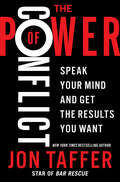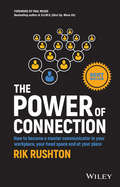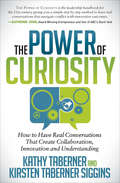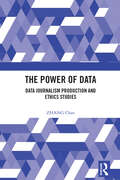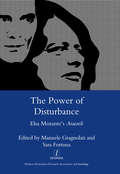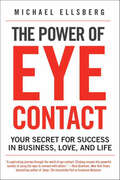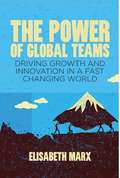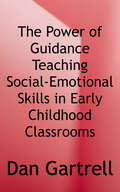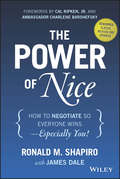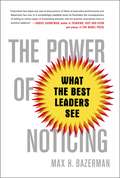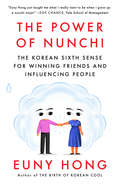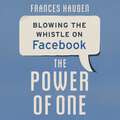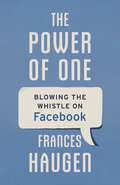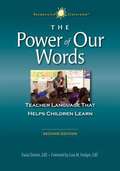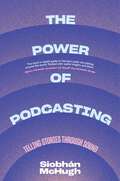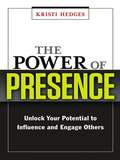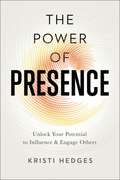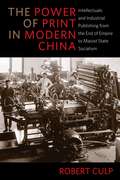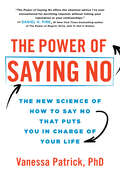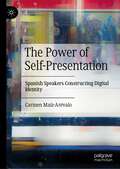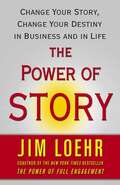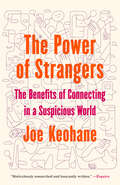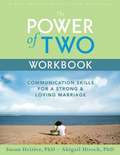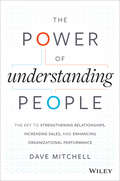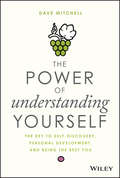- Table View
- List View
The Power of Conflict
by Jon TafferStar and executive producer of the hit TV show Bar Rescue and New York Times bestselling author of Don't Bullsh*t Yourself, Jon Taffer reveals the transformational power of conflict, sharing his toolkit for arguing smarter—at home, at work, and in life.Most people try their best to avoid conflict. Bar Rescue host Jon Taffer understands that. Conflict can have negative results. It’s easy to think that the key to a happy workplace or marriage is to avoid conflict. In reality, that’s not the case—the key is to argue smarter.Enter the Toolkit for Getting Conflict Right. Taffer’s approach is focused on deliberate conflict—otherwise known as “conflict with a purpose.” There are selective and strategic ways to have difficult conversations, and when doing so, to stay aware of your objectives rather than escalating tension unnecessarily. As Taffer explains, “The key is to act affirmatively, constructively, and productively.” Eliminating conflict isn’t always the answer; inevitably there will be times when it will arise. Engaging in conflict can be a way to clear the air, and get to the bottom of issues that, once resolved, can strengthen friendships, ease tensions at work, and address problems before they have a chance to bubble over.With easy-to-follow advice that shows how to best engage in constructive discourse to get the results you want, The Power of Conflict provides you with the rules to argue smarter, uphold your values, and keep the conversation real. The step-by-step guide starts with the inception of the conflict and carries through the difficult conversation’s conclusion, arming readers with the skills and confidence to fight for their principles.
The Power of Connection: How to Become a Master Communicator in Your Workplace, Your Head Space and at Your Place
by Rik RushtonA simple communication framework to begin practising today We all carry around the technology to stay connected 24/7, yet many of us are disengaged and challenged with our lack of communication skills. The Power of Connection provides you with practical, real-world solutions for improving your professional performance, your personal relationships and your outlook — one conversation at a time. Becoming a confident and compelling communicator might be the most important skill for leaders in the modern business landscape, parents in the modern home and individuals who use ‘self-talk' to help shape their world. By adopting the simple strategies revealed in every chapter, you can become an unshakeable success at what you set out to do. This book is designed to help you start communicating better today, so start reading and start practicing with your very next conversation! Understand your communication strengths and weaknesses Become a better listener to build a deeper connection Learn how communication sits at the heart of all relationships Develop the skills to connect, inspire, engage and empower We are surrounded by noise, yet no one is actually saying anything we can connect with — or are we just not listening? Communication is a two-way street, and involves so much more than just speaking. The Power of Connection offers a quick and easy road map for your personal journey of growth and development that will make you a better parent, friend, spouse and employee. It's the right message for this time considering there's never a wrong time to level up your skills and become more effective at work, at home and in life.
The Power of Curiosity: How to Have Real Conversations That Create Collaboration, Innovation and Understanding
by Kathy Taberner Kirsten Taberner SigginsUse the power of curiosity to transform challenging conversations into productive, meaningful, relationship-building experiences at work, home, or school. As leaders, parents, or teachers, navigating difficult conversations is part of the job. How do we keep calm and achieve a productive outcome, all while keeping our relationships intact? The secret is curiosity. Curiosity is the innovation-driving, emotion-calming skill that comes so naturally to us as children, but gets so easily buried beneath our busy, multitasking lifestyles. The good news is that we simply have to relearn what we already know! In The Power of Curiosity, mother-daughter executive coaching team Kathy Taberner and Kirsten Taberner-Siggins walk you through the Curiosity Skills and introduce a step-by-step process to use anytime—but especially when challenging conversations arise. In The Power of Curiosity you&’ll learn: How to be fully present in every conversation, even when distractions aboundThe five listening choices you always have available at home, work, or schoolSpecific calming strategies to access when negative emotions run high A step-by-step process to transform potential conflict into relationship-building opportunities.
The Power of Data: Data Journalism Production and Ethics Studies
by ZHANG ChaoThis book is a theoretical work on data journalism production that drills down the models, narratives, and ethics. From idea to concept and then to a widespread innovative trend, data journalism has become a new global paradigm, facilitating the transformation to focus on data, convergence, and intelligence. Drawing on various theoretical resources of communication, narratology, ethics, management, literature and art, game studies, and data science, this book explores the cutting-edge issues in current data journalism production. It critically analyzes crucial topics, including the boundary generalization of data journalism, data science methodology, the illusion of choice in interactive narratives, the word-image relationship in data visualization, and pragmatic objectivity and transparency in production ethics. Provided with a toolbox of classic examples of global data journalism, this book will be of great value to scholars and students of data journalism or new media, data journalists, and journalism professionals interested in the areas.
The Power of Disturbance: Elsa Morante's "Aracoeli"
by Sara FortunaAracoeli (1982) was the last novel written by Elsa Morante (1912-85), one of the most significant Italian writers of the twentieth century. The journey, both geographical and memorial, of a homosexual son in search of his dead mother is a first-person narrative that has puzzled many critics for its darkness and despair. By combining scholars from different disciplines and cultural traditions, this volume re-evaluates the esthetical and theoretical complexity of Morante's novel and argues that it engages with crucial philosophical and epistemological questions in an original and profound way. Contributors explore the manifold tensions staged by the novel in connection with contemporary philosophical discourse (from feminist/queer to political theory to psycho-analysis) and authors (such as Emilio Gadda, Pier Paolo Pasolini and Pedro Almodovar). The Power of Disturbance shows that by creating a 'hallucinatory' representation of the relationship between mother and child, Aracoeli questions the classical distinction between subject and object, and proposes an altogether new and subversive kind of writing. Manuele Gragnolati teaches Italian literature at Oxford University, where he is a Fellow of Somerville College. Sara Fortuna teaches philosophy of language at the Universita Guglielmo Marconi in Rome.
The Power of Eye Contact: Your Secret for Success in Business, Love, and Life
by Michael Ellsberg“Both mysterious and rewarding, the text reveals the powerful secrets of using the eyes to connect with others” (Rom Brafman, co-author of Sway).Eye contact can land you a job. It can get you a date. It can deepen your connections with the people you love. It can make or break business relationships. It can help win a fight. It can win over an audience.Simply put, eye contact is one of the most powerful tools in human face-to-face interaction. The Power of Eye Contact is your concise guide to harnessing the potent force of eye contact. Master this force and you will notice three things:You meet more peopleYour connections deepen with family, friends, and business prospectsYou look, feel, and act more confidentThe Power of Eye Contact is your invaluable tool to enhance your relationships in every part of your life.
The Power of Global Teams
by Elisabeth MarxThis highly practical book explains how executive teams in global companies can work together to successfully drive change, enable fast growth or restructure the business. It demonstrates a clear correlation between team development and business results and even deals with special issues for teams in the not-for-profit sector and emerging markets.
The Power of Guidance: Teaching Social-emotional Skills in Early Childhood Classrooms
by Dan GartrellChildcare providers and teachers in preschool and primary grade settings will greatly value the collection of writings in The Power of Guidance: Teaching Social-Emotional Skills In the Early Childhood Classroom. The writings provide a concise yet multi-faceted overview of the guidance approach used with this age group. The book examines the differences between patience and understanding and between misbehavior and mistaken behavior, important distinctions that must be made in order to understand and deal with various behaviors using the guidance approach. Readers also will learn the components of an encouraging classroom and strategies for maintaining it, leading to non-punitive approaches for classroom management. One chapter puts particular focus on intervention strategies with boys, a topic readers often seek out. The book has the distinction of being selected as a comprehensive member benefit for the NAEYC for 2003.
The Power of Nice: How to Conquer the Business World With Kindness
by Ronald M. Shapiro James Dale Cal Ripken Jr. Ambassador Charlene BarshefskyLearn to get what you want without burning bridges In this revised and updated edition of the renowned classic The Power of Nice, negotiations expert, sports agent, New York Times bestselling author, attorney, business leader and educator, Ron Shapiro, shares the key principles of effective negotiation through a combination of a time-tested process, anecdotes, and exercises. <P><P>Drawing on his unparalleled experiences from the worlds of sports, law, business and politics, as well as dealing with life issues common to us all, Shapiro takes you through the steps of his systematic approach: The Three Ps, Prepare-Probe-Propose. Learn how to use the process to empower you in negotiations. Regardless of your level of experience or the extent of your confidence, you will get what you want while building stronger relationships for the future. This updated edition contains: Significant new material including an expanded view of its applicability to a broad array of business and life challenges a new streamlined version of the Preparation Checklist a more precise understanding of the concept of WIN-win forewords by Cal Ripken, Jr., and Ambassador Charlene Barshefsky, and an Epilogue highlighting negotiation lessons from the life of Nelson Mandela The book also provides a link to reinforcement of its lessons through the website of the Shapiro Negotiations Institute. Whether you are negotiating with, among others, a customer or client, a boss or government official, or even setting a teenager's curfew or getting a last seat on an airplane, this invaluable guide will help you read the other side and bring the power of human psychology and a time-tested process to the negotiating table. If you're tired of uneven "compromise" and the feeling of being manipulated, turn the tables for good with The Power of Nice, and learn strength from the master himself.
The Power of Noticing
by Max BazermanFrom Harvard Business School Professor and Co-Director of the Harvard Kennedy School's Center for Public Leadership: A guide to making better decisions, noticing important information in the world around you, and improving leadership skills.Imagine your advantage in negotiations, decision-making, and leadership if you could teach yourself to see, and evaluate, information that others overlook. The Power of Noticing provides the blueprint for accomplishing precisely that. Max Bazerman, an expert in the field of applied behavioral psychology, draws on three decades of research and his experience instructing Harvard Business School MBAs and corporate executives to teach you how to notice and act on information that may not be immediately obvious. Drawing on a wealth of real-world examples, from the Challenger Space Shuttle disaster to Bernie Madoff's Ponzi scheme, Bazerman diagnoses what information went ignored in these situations, and why. Using many of the same case studies and thought experiments designed in his executive MBA classes, he challenges readers to explore their cognitive blind spots, identify any salient details they are programmed to miss, and then take steps to ensure it won't happen again. While many bestselling business books have explained how susceptible to manipulation our irrational cognitive blindspots make us, Bazerman helps you avoid the habits that lead to poor decisions and ineffective leadership in the first place. His book provides a step-by-step guide to breaking bad habits and spotting the hidden details that will change your decision-making and leadership skills for the better, teaching you to: pay attention to what didn't happen; acknowledge self-interest; invent the third choice; and realize that what you see is not all there is. With The Power of Noticing at your side, you can learn how to notice what others miss, make better decisions, and lead more successfully.
The Power of Nunchi: The Korean Secret to Happiness and Success
by Euny HongImprove your nunchi. Improve your life.The Korean sixth sense for winning friends and influencing people, nunchi (pronounced noon-chee) can help you connect with others so you can succeed in everything from business to love. The Power of Nunchi will show you how.If you're thinking, "Not another Eastern fad: Marie Kondo already made me throw away half my clothes," don't worry--it's not a fad. Nunchi has been used by Koreans for more than 5000 years. It's what catapulted their nation from one of the world's poorest to one of the richest and most technologically advanced in half a century. And it's why K-pop--an unlikely global phenomenon, performed as it is in a language spoken only in Korea--is even a thing.The art of reading a room and understanding what others are thinking and feeling, nunchi is a form of emotional intelligence that anyone can learn--all you need is your eyes and ears. Have you ever wondered why your less-skilled coworker gets promoted before you, or why that one woman from your yoga class is always surrounded by adoring friends? They probably have great nunchi. Sherlock Holmes has great nunchi. Cats have great nunchi. Steve Jobs had great nunchi. With its focus on observing others rather than asserting yourself--it's not all about you!--nunchi is a refreshing antidote to our culture of self-promotion, and a welcome reminder to look up from your cell phone.Not some quaint Korean custom like taking off your shoes before entering a house, nunchi is the currency of life. The Power of Nunchi will show you how the trust and connection it helps you to build can open doors for you that you never knew existed.
The Power of One: Blowing the Whistle on Facebook
by Frances HaugenWhistleblower Frances Haugen's exposé of the internal workings of Facebook revealing the company's struggles to regain control over its platform and to stop the spread of misinformationIn the spring of 2021, when news outlets feasted on "the Facebook Files," Frances Haugen went public as the former employee who blew the whistle on the company by copying tens of thousands of documents. She testified to Congress and spoke to the media. She was hailed at President Biden's first State of the Union Address. She made sure everyone understood exactly what the documents revealed: Facebook not only set its algorithm to reward extremism, it knew that its customers were using the platform to foment violence, to spread falsehoods, to diminish the self-esteem of young people, and more. But how was it that Frances was the only employee at the company who dared to step forward?The answer to that question is an inspiring tale of one young woman's life. She grew up in an unhappy home and threw herself into schoolwork and her high school debate team. She made the unusual decision to join the founding class of a new engineering school in Massachusetts, even though it wasn't yet accredited. Prior to attending Harvard Business School, she out-hustled a raft of candidates to win a coveted job at Google as a product manager in a department that was 88% male-and a huge challenge for a woman to survive. In business school, she again didn't fit in. But at each step of the way, including at Pinterest and Yelp, she focused on what mattered, and ignored her critics. She learned the hard way that you can't please everyone, and you have to fight the battles that matter.The Power of One is equally inspiring-the story of a woman who went against the grain, again and again, and changed the world-and horrifying, as the culture and practices of Facebook are brought to the bright light of day, for the first time.(P)2023 Hachette Audio
The Power of One: Blowing the Whistle on Facebook
by Frances Haugen**Available for pre-order: Whistleblower Frances Haugen's searing exposé of the internal workings of Facebook revealing the company's struggles to regain control over its platform and to stop the spread of misinformation**__________In the spring of 2021, when news outlets feasted on "the Facebook Files," Frances Haugen went public as the former employee who blew the whistle on the company by copying tens of thousands of documents. She testified to Congress and spoke to the media. She was hailed at President Biden's first State of the Union Address. She made sure everyone understood exactly what the documents revealed: Facebook not only set its algorithm to reward extremism, it knew that its customers were using the platform to foment violence, to spread falsehoods, to diminish the self-esteem of young people, and more. But how was it that Frances was the only employee at the company who dared to step forward?The answer to that question is an inspiring tale of one young woman's life and the choices she made. From an isolated childhood in Iowa to an unaccredited college, to one among the few women at Google in its heyday, Frances Haugen learned how to focus on what mattered, and to ignore her critics. To harness the strength of standing in the truth.The Power of One is equally inspiring - the story of a woman who went against the grain, again and again, and changed the world - and horrifying, as the culture and practices of Facebook are brought into the bright light of day, for the first time.__________
The Power of Our Words: Teacher Language that Helps Children Learn (Second Edition)
by Paula DentonSimple changes in a teacher's language can bring about profound changes in students and classrooms. By paying attention to your words and tone of voice, you will: Increase students' engagement with academicsBuild positive communityMore effectively manage your classroom That is the message of The Power of Our Words, a book that has changed the teaching lives of tens of thousands of educators since it was first published in 2007. In this updated second edition you will find practical information to help you: Lead students in envisioning themselves achieving successUse questions that encourage deep and creative thinkingListen to students in ways that support their growthReinforce students efforts and remind or redirect them when they go off track. Throughout, you will find an increased emphasis on using teacher language to support academic engagement and critical thinking skills as called for in the Common Core State Standards. And an updated, livelier format makes this second edition even easier to read.
The Power of Podcasting: Telling Stories Through Sound
by Siobhàn McHughPodcasts have become an essential part of popular culture for millions of listeners. They provide a new way to absorb information that once might have been read in newspapers, books, or magazines or heard over the radio. Podcasting is hailed for its intimacy and authenticity in an age of mistrust and disinformation. But while it is relatively easy to make a podcast, it is much harder to make a great one.In The Power of Podcasting, award-winning podcast producer and leading international audio scholar Siobhán McHugh dissects what makes a good podcast and outlines how you can create one yourself. She blends practical insights into and critical analysis of the art of audio storytelling. Packed with case studies, history, tips, and techniques from McHugh’s decades of experience, this book brings together a wealth of knowledge to introduce readers to the possibilities of the world of sound.If you’ve ever said you want to start a podcast, this is the book you need to understand the craft, the history, and the power of creating meaningful stories through sound.
The Power of Presence: Unlock Your Potential to Influence and Engage Others
by Kristi HedgesEveryone recognizes leaders with presence. They stand out for their seemingly innate ability to command attention and inspire commitment. But what is this secret quality they exude, exactly? Executive and CEO coach Kristi Hedges demystifies this elusive trait, revealing that leadership presence is the intersection of outward influencing skills and internal mental conditioning. Using her I-Presence model, the author shows how anyone regardless of position or personality can strengthen their impact. Readers will learn how to build trust as the foundation for leadership, eschew perfectionism for authenticity, banish limiting thoughts and behaviors, and galvanize their team through visionary, inspiring communications. Stellar technical knowledge, a strong work ethic, excellent presentation skills none of these tangible traits puts people on the career fast track as readily as a compelling presence. Filled with profiles of leaders with powerful presence and the latest neuroleadership research translated into actionable habits, this authoritative guide puts a little-understood, but potentially game-changing, tool within everyones reach.
The Power of Presence: Unlock Your Potential to Influence and Engage Others
by Kristi HedgesEveryone, regardless of position or personality, can strengthen their presence. The Power of Presence shows how.When some people speak, everyone listens. When they need commitment to projects, others jump on board. They just seem to have that indescribable &“presence&”--a subtle magnetic field around them wherever they go that signals authority and authenticity and attracts disciples with ease. Wouldn&’t it be incredible if doors opened as effortlessly for you? How amazing would it be if you could command the room like they do? You don&’t have to wonder; you can make it happen!Filled with strategies, exercises, and personal stories from years spent coaching leaders, communications expert Kristi Hedges explains how to:Build relationships based on trustRid yourself of limiting behaviorsEmbody the values you are trying to conveyExplore how others see you and correct misperceptionsCommunicate in way that inspireThe key is to cultivate the communication aptitude, mental attitude, and unique leadership style needed to connect with and motivate others. Everyone recognizes a commanding presence when they see it, and soon they&’ll see it in you!
The Power of Print in Modern China: Intellectuals and Industrial Publishing from the End of Empire to Maoist State Socialism (Studies of the Weatherhead East Asian Institute, Columbia University)
by Robert CulpAmid early twentieth-century China’s epochal shifts, a vital and prolific commercial publishing industry emerged. Recruiting late Qing literati, foreign-trained academics, and recent graduates of the modernized school system to work as authors and editors, publishers produced textbooks, reference books, book series, and reprints of classical texts in large quantities at a significant profit. Work for major publishers provided a living to many Chinese intellectuals and offered them a platform to transform Chinese cultural life.In The Power of Print in Modern China, Robert Culp explores the world of commercial publishing to offer a new perspective on modern China’s cultural transformations. Culp examines China’s largest and most influential publishing companies—Commercial Press, Zhonghua Book Company, and World Book Company—during the late Qing and Republican periods and into the early years of the People’s Republic. He reconstructs editors’ cultural activities and work lives as a lens onto the role of intellectuals in cultural change. Examining China’s distinct modes of industrial publishing, Culp explains the emergence of the modern Chinese intellectual through commercial and industrial processes rather than solely through political revolution and social movements. An original account of Chinese intellectual and cultural history as well as global book history, The Power of Print in Modern China illuminates the production of new forms of knowledge and culture in the twentieth century.
The Power of Saying No: The New Science of How to Say No that Puts You in Charge of Your Life
by Vanessa Patrick PhD"If you're tired of agreeing to annoying asks and thankless tasks, read this book. The Power of Saying No offers the smartest advice I've ever encountered for declining requests without risking your reputation or your relationships. This essential guide will sharpen your mind and steel your spine to live life on your own terms." —Daniel H. Pink, #1 New York Times bestselling author of The Power of Regret, Drive, and To Sell Is HumanStop saying yes. Start saying no. Change your life!You have probably said "yes" to bosses, partners, family, friends, and even strangers, when you actually want to say "no." Maybe you wish you could say no more often, but you're not sure how or if it's even possible to do so. You're not alone! We're taught to say yes as often as we can. After all, if you say no, aren't you likely to miss out on opportunities and sever important relationships? Isn't saying no a harmony-buster?In The Power of Saying No, award-winning professor and researcher Vanessa Patrick delves into the new science of saying no. She introduces the ground-breaking concept of "empowered refusal"—a proven framework for saying no that puts you in charge of your life—and reveals some surprising secrets about the power of the word no.Dr. Patrick shares:Why empowered refusal is a valuable superskill that helps us say no in a way that does not invite pushback from others.The toolkit of three competencies you need to develop to effectively communicate an empowered no response.A framework to help separate the "good-for-me" from the "not-good-for-me" activities and engagements that come our way.How to establish and implement personal policies that empower your refusal.How to use empowered refusal to manage difficult askers, strengthen your relationships and realize your full potential.It's more important than ever to protect your time, focus on your top priorities, and use the power of saying no to reach your goals at work and at home. Empowered refusal is a unique, positive, and meaning-filled approach to managing your energy and ambition effectively, allowing you to make lasting, positive changes in your life.This empowering book is a fascinating read that will help you with conflict resolution, boundaries, communication, and difficult conversations!"The Power of Saying No will stay within arm's reach for me. It offers the explanations and the inspirations I need to take charge of my life and career, with concrete tools to make it happen. I was able to put Vanessa Patrick's lessons to work the day I started reading the book and have continued every day since. Read this book. Twice." —Dolly Chugh, author of The Person You Mean to Be and A More Just Future, Jacob B. Melnick Term Professor at the NYU Stern School of Business
The Power of Self-Presentation: Spanish Speakers Constructing Digital Identity
by Carmen Maíz-ArévaloThis book follows a Goffmanian approach to self-presentation to focus on the different strategies Spanish users employ to construct their digital identity in profiles, biographies, pictures, and statuses on platforms such WhatsApp, Twitter, Facebook, Instagram and LinkedIn. The author presents a functioning taxonomy of self-presentation strategies along the front-stage/back-stage continuum, including common strategies such as eudaimonic (or inspirational) messages and the use of humour. Special attention is paid to the effects of social variables such as the users' gender and age, and the perceived purposes of the different platforms (e.g. LinkedIn is often intended as a professional market for job hunting, whereas Facebook is rarely used in this context). The book will be of interest to students and scholars of Technologically Mediated Communication (traditionally known as Computer-Mediated Communication or CMC), media communication, internet pragmatics, digital discourse analysis, and related fields.
The Power of Story: Rewrite Your Destiny in Business and in Life
by Jim LoehrNew York Times bestselling coauthor of The Power of Full Engagement, examines the way we tell stories about ourselves to ourselves and, most importantly, the way we can change those stories to transform our business and personal lives. "Your story is your life," says Loehr. As human beings, we continually tell ourselves stories—of success or failure; of power or victimhood; stories that endure for an hour, or a day, or an entire lifetime. We have stories about our work, our families and relationships, our health; about what we want and what we're capable of achieving. Yet, while our stories profoundly affect how others see us and we see ourselves, too few of us even recognize that we're telling stories, or what they are, or that we can change them—and, in turn, transform our very destinies. Telling ourselves stories provides structure and direction as we navigate life's challenges and opportunities, and helps us interpret our goals and skills. Stories make sense of chaos; they organize our many divergent experiences into a coherent thread; they shape our entire reality. And far too many of our stories, says Loehr, are dysfunctional, in need of serious editing. First, he asks you to answer the question, "In which areas of my life is it clear that I cannot achieve my goals with the story I've got?" He then shows you how to create new, reality-based stories that inspire you to action, and take you where you want to go both in your work and personal life. For decades, at the Human Performance Institute, Loehr has been examining the power of story to increase engagement and productivity, and Fortune 500 companies have paid millions to send employees to his program, in which he applies the principles and methods that he now offers in this book. Global business leaders, world-class athletes, military special forces, and thousands of individuals from every walk of life have sought out and benefited from his life-altering insight and expertise. Our capacity to tell stories is one of our profoundest gifts. Loehr's approach to creating deeply engaging stories will give you the tools to wield the power of storytelling and forever change your business and personal life.
The Power of Strangers: The Benefits of Connecting in a Suspicious World
by Joe KeohaneAn entertaining, surprising, and ultimately inspiring look at what happens when we talk to strangers, and why it affects everything from our own health and well-being to the rise and fall of nations in the tradition of Susan Cain&’s Quiet and Yuval Noah Harari&’s Sapiens&“This lively, searching work makes the case that welcoming &‘others&’ isn&’t just the bedrock of civilization, it&’s the surest path to the best of what life has to offer.&”—Ayad Akhtar, Pulitzer Prize–winning author of Homeland ElegiesIn our cities, we stand in silence at the pharmacy and in check-out lines at the grocery store, distracted by our phones, barely acknowledging one another, even as rates of loneliness skyrocket. Online, we retreat into ideological silos reinforced by algorithms designed to serve us only familiar ideas and like-minded users. In our politics, we are increasingly consumed by a fear of people we&’ve never met. But what if strangers—so often blamed for our most pressing political, social, and personal problems—are actually the solution?In The Power of Strangers, Joe Keohane sets out on a journey to discover what happens when we bridge the distance between us and people we don&’t know. He learns that while we&’re wired to sometimes fear, distrust, and even hate strangers, people and societies that have learned to connect with strangers benefit immensely. Digging into a growing body of cutting-edge research on the surprising social and psychological benefits that come from talking to strangers, Keohane finds that even passing interactions can enhance empathy, happiness, and cognitive development, ease loneliness and isolation, and root us in the world, deepening our sense of belonging. And all the while, Keohane gathers practical tips from experts on how to talk to strangers, and tries them out himself in the wild, to awkward, entertaining, and frequently poignant effect.Warm, witty, erudite, and profound, equal parts sweeping history and self-help journey, this deeply researched book will inspire readers to see everything—from major geopolitical shifts to trips to the corner store—in an entirely new light, showing them that talking to strangers isn&’t just a way to live; it&’s a way to survive.
The Power of Two Workbook
by Susan M. Heitler Abigail Heitler HirschThe Power of Two Workbook teaches the communication and conflict resolution skills that can enable you to enjoy a great marriage. With this practical step-by-step guide you'll learn how to evoke interest, not antagonism, when you speak about sensitive issues; and to listen without becoming defensive. You'll discover secrets to effective dialogue, techniques for cleaning up after inadvertent "toxic spills," and ways to ensure that apologies yield healing -- plus you'll learn the three-step waltz of smooth shared decision-making, how to keep anger ceilings low, and strategies for converting moments of anger into powerful opportunities for learning and growth. With each chapter you'll acquire key skills for a happier, more gratifying marriage. A host of engaging practice exercises give you a chance to repeat each skill often enough that it can become yours. Book jacket.
The Power of Understanding People: The Key to Strengthening Relationships, Increasing Sales, and Enhancing Organizational Performance
by Dave MitchellHow to build lasting connections through meaningful communication Developing successful relationships is critical to our success in both our personal and professional lives. The Power of Understanding People shows you how to establish and develop extremely effective relationships by providing you with techniques to better identify and understand the intrinsic needs of others. As a result, you will achieve better team dynamics, increased sales and client satisfaction, higher levels of employee engagement and performance, and even more satisfying marriages and friendships. This book provides the tools to understand others' unique communication style as well as your own. Get detailed advice on how to adjust to diverse communication styles, develop a unifying language for the organization, and better match motivational techniques to team members. Through storytelling and experiential exercises, author Dave Mitchell helps you gain insight into your own unique interaction style and teaches you how to communicate, motivate, sell, and service more successfully no matter the personality types involved. Offers insight into the behavior cues and questions to ask to better understand someone's interactive preferences Explains how to enhance your sales efforts by better targeting your brand message to the client's style so that your products/services resonate with them more Examines strategies for creating a high performing work environment and achieve greater customer service excellence Contains conflict resolution strategies, including how to effectively work out differences within a team, between work units, with customers, and even in your personal life Armed with the ability to interpret the behavior of the people around you, you will achieve greater levels of success at work and at home while also learning how to better handle the difficult situations involving people in your life.
The Power of Understanding Yourself: The Key to Self-Discovery, Personal Development, and Being the Best You
by Dave MitchellDiscover your true self and align your life journey around your core beliefs, values and perspective. Designed as both a companion piece to the author's previous book, The Power of Understanding People, and a stand-alone work, The Power of Understanding Yourself provides readers with a blueprint for examining their true purpose and approach to life and a map for achieving greater personal happiness, professional success and self-awareness. It explores personal attributes related to interactive style, diving deeper into the concepts from the author's previous book, provides exercises for exploring how to connect your current life status to a desired future state and encourages readers to engage in a deep exploration of their core values, beliefs, mission and vision to become their best self. • Find the key to self-discovery and personal development • Uncover your true purpose • Use helpful exercises to reveal the best you • Develop strategies to maximize your potential The Power of Understanding Yourself is an empowering tool to help you find your best possible self and flourish.
